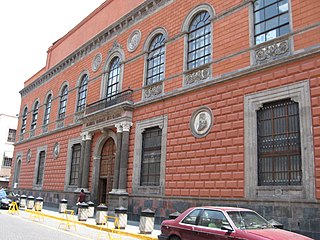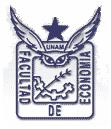
The National Autonomous University of Mexico is a public research university in Mexico. A portion of Ciudad Universitaria is a UNESCO World Heritage site that was designed and decorated by some of Mexico's best-known architects and painters of the 20th century. The campus also hosted the main events of the 1968 Summer Olympic Games. All Mexican Nobel laureates are alumni or faculty of UNAM. UNAM is known for its rigorous admissions, with acceptance rates often under 10%. Its research and education are also globally recognized for their excellence and impact. UNAM was founded, in its modern form, on 22 September 1910 by Justo Sierra as a secular alternative to its predecessor, the Royal and Pontifical University of Mexico. UNAM was also the birthplace of the student movement of 1968.

Andrés Manuel del Río y Fernández was a Spanish scientist, naturalist and engineer, nationalized Mexican, who discovered compounds of vanadium in 1801. He proposed that the element be given the name panchromium, or later, erythronium, but his discovery was not credited at the time, and his names were not used.

Universidad La Salle also referred to by its acronym ULSA is a private Catholic secondary and higher education institution run by the Institute of the Brothers of the Christian Schools in 15 campuses in Mexico. It offers high school, bachelor, master and Ph.D degrees. It has had an expansion in the country, creating its own university national system. Its main campus is located in Mexico City, and has a presence in Ciudad Obregón, Chihuahua, Gomez Palacio, Monterrey, Ciudad Victoria, Leon, Morelia, Pachuca, Ciudad Nezahualcóyotl, Puebla, Oaxaca, Cancun, Cuernavaca and Saltillo.

Ciudad Universitaria is the main campus of the National Autonomous University of Mexico (UNAM), located in Coyoacán borough in the southern part of Mexico City. Designed by architects Mario Pani and Enrique del Moral, it encloses the Olympic Stadium, about 40 faculties and institutes, the Cultural Center, an ecological reserve, the Central Library, and a few museums. It was built during the 1950s on an ancient solidified lava bed in Coyoacán called "El Pedregal" to replace the scattered buildings in downtown Mexico City where classes were given. It was completed in 1954 at a cost of approximately $25 million. At the time of its completion it was the largest single construction project in Mexico since the Aztecs. It was declared a World Heritage Site by UNESCO in 2007.

Luis Ernesto Miramontes Cárdenas was a Mexican chemist known as co-inventor and the first to synthesize an oral contraceptive, progestin norethisterone.

Universidad Juárez Autónoma de Tabasco is a public institution of higher learning located in Villahermosa, Tabasco, Mexico. The mission of the university is "to prepare professionals with broad and deep expertise in their area of study to fill the needs of Tabasco and the country at large." UJAT is the largest and most prominent university in the state of Tabasco. During the 2007-2008 academic year the university enrolled 35,271 students and had a teaching staff of over 2,000. For the same school year the university offered bachelor's degrees in 36 disciplines, master's degrees in 26 areas, three doctoral degrees, and post-graduate Certificates (Especialidades) in 17 graduate areas of specialization. The university grants law, education, management, engineering, medicine, architecture, nursing, and dentistry degrees, plus some 30 additional degrees in other fields of study.

The National College is a Mexican honorary academy with a strictly limited membership created by presidential decree in 1943 in order to bring together the country's foremost artists and scientists, who are periodically invited to deliver lectures and seminars in their respective area of speciality. Membership is generally a lifelong commitment, although it could be forfeited under certain conditions. It should not be confused with El Colegio de México, a public institution of higher education and research.

The School of Accounting and Administration of the National Autonomous University of Mexico (UNAM-FCA) is an educational institution in Mexico. Its student enrollment is made up of more than thirteen thousand students, while the school has more than 1300 lectures and faculty members. The School currently hosts 3 majors, Accounting, Administration and Informatics in the UNAM. It has Undergraduate and Graduate programs, being the later some of the most popular in the University, being the only MBA in Ciudad Universitaria.
The Engineering Institute is the research institute of the UNAM in Mexico City which focuses on engineering-related topics. It operates the postgraduate programs of the Faculty of Engineering (UNAM).

UNAM'sSchool of Medicine is the medical school of the National Autonomous University of Mexico (UNAM), located at the university's main campus of Ciudad Universitaria. Established in 1553 as part of the Royal and Pontifical University of Mexico, it is one of the oldest medical schools in the Americas. The school has undergraduate and graduate studies departments. It does joint teaching with some other schools, e.g., the School of Science. It also has many grants involving UNAM's Engineering School, in areas such as smart and connected health. It is one of the most recognized schools in the university and in Mexico. The latest three rectors of the university, including the current one, are former deans from this school.

The School of Architecture at UNAM is one of the leading schools of architecture and design in Mexico. It offers undergraduate and postgraduate studies in architecture, landscape architecture, urbanism and industrial design.

The School of Engineering of the National Autonomous University of Mexico is the division of the aforementioned university in charge of engineering and applied studies in the physical and natural sciences. At the undergraduate level, it offers thirteen majors and some graduate programs. In fall 2008, the school of engineering had over 10,900 undergraduate students and 1,115 graduate students and postdocs. Chemistry and chemical engineering are offered neither by the School of Engineering nor the School of Sciences, but by a separate School of Chemistry.
Francisco José Barnés de Castro is a Mexican academic and consultant. From 6 January 1997 to 12 November 1999 he served as rector of the National Autonomous University of Mexico (UNAM), the largest university in the Spanish-speaking world.

The Faculty of Sciences at the National Autonomous University of Mexico (UNAM) is the entity where natural and exact science-based majors are taught. It has both undergraduate and graduate studies, some of the former in joint teaching with other faculties, most commonly the Faculty of Engineering. The Faculty of Sciences is the most important science school in the country by the number of students and the quality of its research. Together with the research institutes that surround it, it is considered one of the biggest research complexes of the UNAM.

The history of science and technology in Mexico spans many years.

The Academy of San Carlos is located at 22 Academia Street in just northeast of the main plaza of Mexico City. It was the first major art academy and the first art museum in the Americas. It was founded in 1781 as the School of Engraving and moved to the Academia Street location about 10 years later. It emphasized the European classical tradition in training until the early 20th century, when it shifted to a more modern perspective.

The School of Economics is the dependence of the National Autonomous University of Mexico responsible for conducting research and teaching in economics. Has its direct predecessor in the so-called National School of Economics.
Juan Manuel Lozano Mejía was a recognized Mexican physicist. He was one of the pioneers of nuclear physics in Mexico and an academic at Universidad Nacional Autónoma de México for over fifty years.

Enrique del Moral Dominguez was a Mexican architect and an exponent of the functionalism movement, a modernist group that included Mexican artists and architects such as José Villagrán Garcia, Carlos Obregón Santacilia, Juan O'Gorman, Eugenio Peschard, Juan Legarreta, Carlos Tarditti, Enrique de la Mora and Enrique Yanez. The movement developed from innovative concepts presented by Frank Lloyd Wright, Le Corbusier, Mies van der Rohe and the Bauhaus school as well as Die Stijl, and remodeled the profile of cosmopolitan Mexico City and other cities in the 1930s.

The Palace of Mining, also Palace of Mines, is a building in Mexico City, Mexico, considered to be a fine example of Neoclassical architecture in the Americas. It was designed and built between 1797 and 1813 by Valencian Spanish sculptor and architect Manuel Tolsá. It was built to house the Royal School of Mines and Mining of the Royal Court at the request of its director, Fausto Elhuyar, a scientifically-trained mineralogist.



















